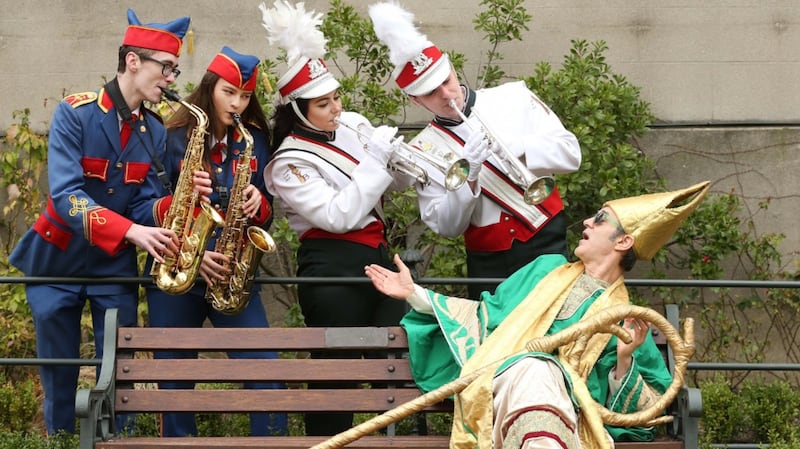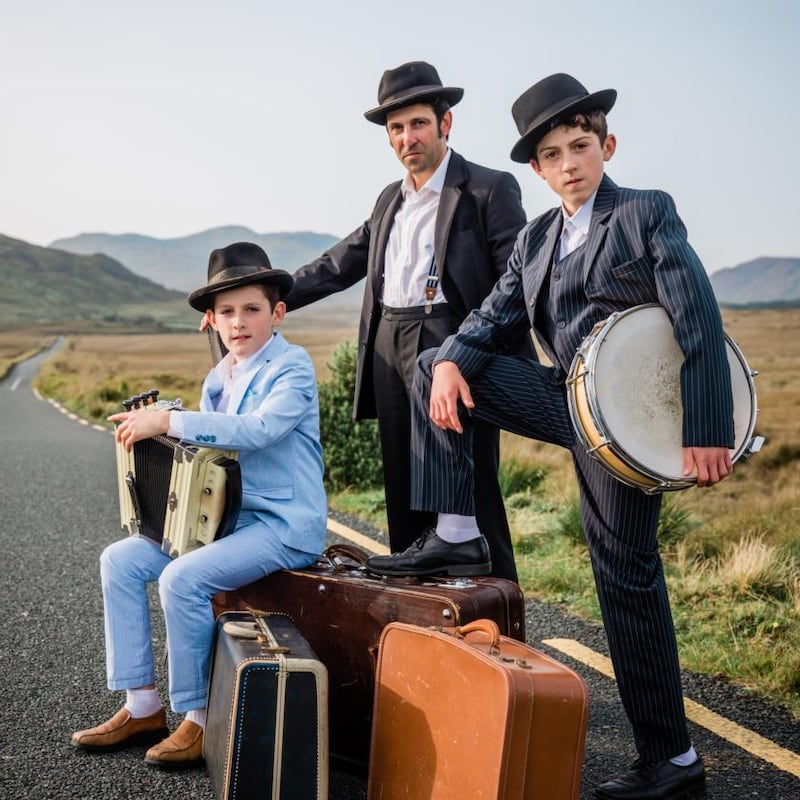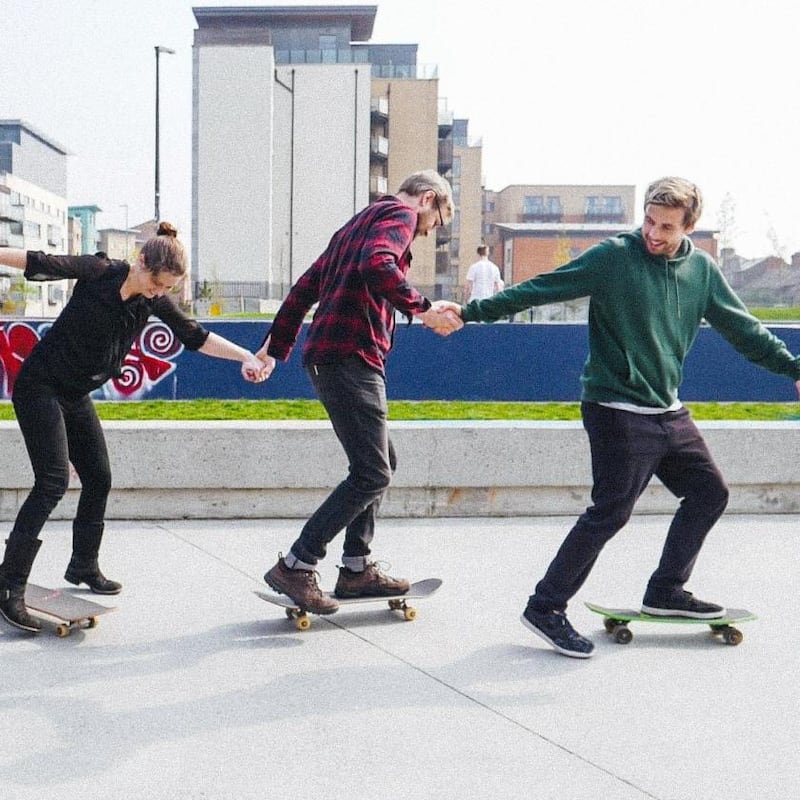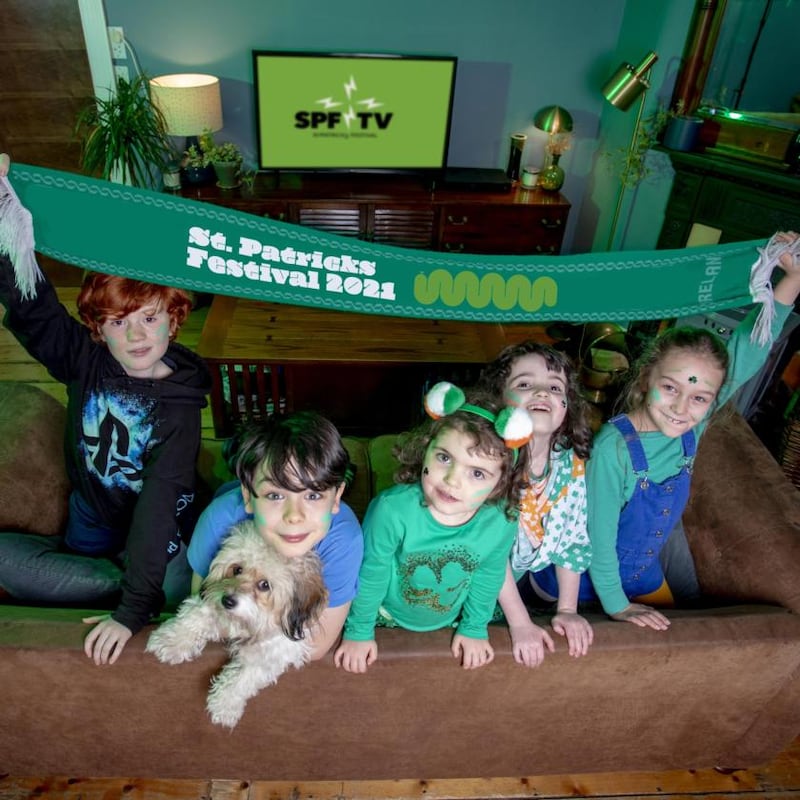This year’s national St Patrick’s Festival is gearing up to be a bit of a positive blast. “It’s been such a long, dark year,” says the festival’s artistic director Karen Walshe. “This is the anniversary of us going down – we were the first festival down on 13th March and that was really difficult.”
Walshe, however, is is upbeat about the pluses of doing things differently. “Here we are a year later, and we wanted to create something that everybody can tune into, and get everything from a history show, a virtual tour of the military archives, to kids’ yoga from the National Gallery, to Bressie has created this magnificent spoken word piece for teens, to beautiful trad music, to our big St Patrick’s night show.”
Try as it might to make a mockery of the national celebration of a friendly, sociable people well up for company and fun (that cliche has truth), Covid will not squash it.
Instead of the usual five-day shindig in the capital with tons of live events for up to 200,000 people, plus half a million on the street for Dublin’s parade, St Patrick’s Festival this year has gone national, and international, via a new six-day TV channel, St Patrick’s Festival TV (SPFTV), both on the box and online worldwide. With a theme Dúisigh Éire!/Awaken Ireland!, it’s calling Irish people to “throw off the long, dark months and rise to embrace brighter days ahead”, connecting “our family of 80 million” via hundreds of virtual events.

The irony of this year, says Walshe, is “what we thought was going to be this weird event that wouldn’t have the lift because it we can’t be in a room together or on the streets, has turned into this huge, beautiful national event like it’s never been before”.
Organisers have partnered with Oireachtas TV to beam the six-day festival into more than 1.1 million Irish homes, quite aside from online globally
After multiple scenario planning, on January 4th the decision was made – a Level 5 festival – and funding confirmed, most of it this year from the Department of Tourism, Culture, Arts, Gaeltacht, Sport and Media, which is putting about €1 million into it, along with €400,000 in business continuity funding through Fáilte Ireland. This means commissioning funds for artists, creators, crew and live entertainment, plus six days of entertainment for all, plus a showcase of Ireland’s culture and heritage.
The strategy, says Walshe, aimed “to funnel money out to all the artists, bands, trad musicians, the pageant companies, circus performers, all the people who would normally be working now in the lead-up to celebrations all over Ireland – not just for the Dublin festival – kicking off their season of work, so they’ll have some income this month.”
They broadened the base, reaching across genres and disciplines. “We asked performers like Tumble Circus or Fanzini Brothers Cirus in Kerry: film yourselves, create a 30- or 15-minute show for us, in your town. Hire your local filmmaker or event crew to produce the film, feed the money out to the pockets of workers in those locations, and let us all zoom in. For example, musician Padraig Jack on the Aran Islands, or Aran knitting workshops, we said: bring in a sense of your place, the people, bring us into your place, your scenery as well as your performance.”
What resulted was hundreds of short films – music, theatre, art, performance, poetry, storytelling, traditional arts, virtual tours, food, culture. Rather than just putting them up on a website, there’s a schedule, and the organisers have partnered with Oireachtas TV to beam the six-day festival into more than 1.1 million Irish homes, quite aside from online globally. It means, says Walsh, “giving an opportunity to reach bigger audiences, and being able to get more artists, who have been decimated through this year, into the programme than ever before. If someone gets 100 people viewing from Ireland, plus they get 1,000 people all over the world, that’s a lot more than in a room for a live event in March last year.”

The scheduling logistics sound challenging, with 90-plus hours of programming over six days, 9.30am until 11pm. “We’ll kick off mornings with mindfulness yoga from Michael Ryan, the president’s yoga teacher, ending with Pomes Penyeach” – music and song at Museum of Literature Ireland, featuring James Joyce’s poetry with Lisa Hannigan, Seán Mac Erlaine, Kevin Murphy and Cora Venus Lunny, produced by Matthew Nolan and Adrian Crowley. In between there’s “content running every minute of the day”, such as Marian Richardson’s daily lunchtime chatshow, Tadhg Byrne’s daily Irish food programme, plus trad performances, comedy sketches, circus and kids’ workshops, a history show, young poets reading old poems, Pavee Point and Roma Centre’s old Traveller songs, a virtual tour of the Book of Kells, Slow Looking Art with IMMA, mini-docs by Irish Architecture Foundation, community groups that can’t do it on the street filmed performing their national dance and song.
The 15- or 30-minute pieces are interspersed with “ad breaks” of short items, such as Manchán Magan’s two-minute sea words Sea Tamagotchi, comedy sketches by Michael Fry, or poems by Pat Ingoldsby.
In the absence of taking to the streets in Irish towns, the pageant companies who are usually the backbone have made half-hour workshop films
Normally by this stage there would be 50 people in a large room in Temple Bar pulling together a massive operation, co-ordinating thousands of parade participants, live shows, plus organising road closures and health and safety. This year the team – from a core six or seven, ramped up fully from January – has pulled it together remotely.
Looking at her spreadsheet for March 12th, Walshe counts 71 individual pieces for broadcast. “Moxie for 25 minutes, followed by a 20-minute electronic performance from Kerry called Polytunnel, a break of smaller bits, a five-minute Poetry Ireland compilation, 14-minute performance of the Arrivalists, a 25-minute documentary Who Is Mister O’Kelly? That’s just over one hour.


“It’s been an opportunity to hit different points of our Irish culture, and present so much more than we’ve ever done before.”
In the absence of taking to the streets in Irish towns, the pageant companies who are usually the backbone have made half-hour workshop films on costumes, masks, float-making, and the public everywhere are encouraged to DIY parade-at-home for a #RTÉVirtualParade (last year the hashtag trended globally).
All this action not being just for those on the island, there’s international marketing and social media, plus the Department of Foreign Affairs is sharing via its global mission, and Tourism Ireland through its international network and advertising. The aim is, says Walshe, to “keep the message alive about Ireland – how beautiful it is, meet our real people, come back and join us whenever you can. And connecting with the global Irish all over the world.
“We’ll all be back live next year and it’ll kick in again,” she says, but for now the festival is thinking big, with a wider range of artists and creators, open to a much larger audience, wherever they are.
St Patrick’s Festival TV is on Oireachtas TV, on all Irish TV platforms, plus worldwide online at stpatricksfestival.ie and on rte.ie/culture. March 12-17, daily 9am-11pm (playback on SPF TV Player until March 21)
Picks of the mix at St Patrick’s Festival 2021

Karen Walshe, up to her shoulders scheduling hundreds of virtual presentations on SPFTV, picks a few of them from the six-day line-up’s strands: SPF Óg with performances, workshops and experiences for families and young people; sounds of contemporary and traditional Irish music; stories exploring Ireland through film, poetry, literature, performance and art; and Living Ireland, reflecting contemporary Irish life.
Tumble Circus presents The MacCarnyson A hammer-smashing Belfast-inspired circus movie with class circus, big laughs and dead-on skill.
Barróg Lá Féile Pádraig (The Big Hug) A huge St Patrick's Night trad set , recorded at Whelan's in Dublin, with Lisa O'Neill, Colm Mac Con Iomaire, Caoimhe Ní Fhlatharta, Séamus and Rónán Ó Flatharta, Diarmuid and Brian Mac Gloin, Cormac Begley, Rónán Ó Snodaigh and Myles O'Reilly, Doireann and Siún Glackin and Mohammad Syfkhan.
Teen Spirit with Bressie Niall Breslin's spoken-word piece brings him back to his school, hearing his musical hero Kurt Cobain had died by suicide, and what Bressie would have said to his teenage self to help his own mental health.
[Indistinct Chatter] Women of Sheriff Street Filmmaker/musician Myles O'Reilly performs an ambient film score live to footage of the Sheriff Street Flats from the 1950s to their demolition in the late 1990s.
Celebrating Pat Ingoldsby, the poet known to a generation of children for his 1980s show Pat's Hat and Pat's Chat on TV, storytelling on Bosco and writing for Wanderly Wagon. Three poetry pieces written in 2020, reflecting our unprecedented times, alongside three of Dublin's finest illustrators and animators.

Seoda: Celtic Connections Celebrating traditional music and cultural connections with performers in different locations. From Ireland, breath singer Ríognach Connolly and guitarist Stuart McCallum. From Scotland, folk musician Bríghde Chaimbeul and violinist Aidan O'Rourke. From Wales, Super Furry Animals frontman Gruff Rhys.
Transitions 30-minute audiovisual vignettes from Irish electronic producers: Sorca Mc Grath, Simon Cullen, New Jackson, Polytunnel and Gareth Quinn Redmond respond to the idea of transition.
A History of Irish Tadhg Byrne. The chef's five-part mini-series showcases Ireland's culinary history from prehistoric times to today, visiting historic locations and chatting with historians, food scientists, foragers, chefs and farmers.
Comhrá le Marian Richardson A series of lunchtime chats with Sabina Higgins, Panti Bliss, Liz Nugent, Cuan Greene and Dr Maeve O' Rourke, at the National Gallery.
Military Archives: History and Virtual Tour Exploring the archival records of the defence forces, the Department of Defence, and the Army Pensions Board, including some of the most important documentary evidence from our struggle for independence.
















